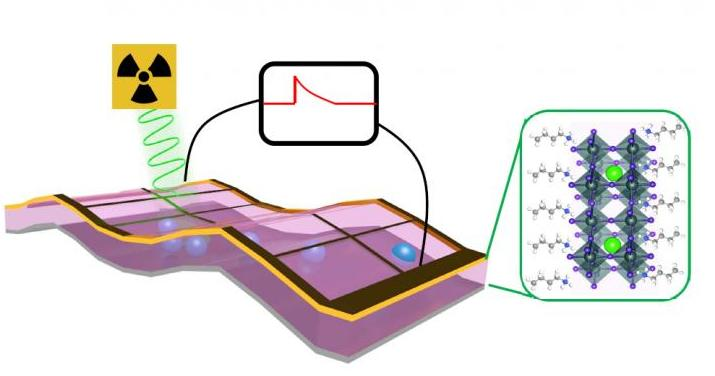Apr 13 2020
Researchers from Argonne National Laboratory and Los Alamos National Laboratory have collaborated to develop a novel X-ray detector prototype that may soon revolutionize medical imaging.
 X-ray detectors made with two-dimensional perovskite thin films convert X-ray photons to electrical signals without requiring an outside power source, and are a hundred times more sensitive than conventional detectors. Image Credit: Los Alamos National Laboratory
X-ray detectors made with two-dimensional perovskite thin films convert X-ray photons to electrical signals without requiring an outside power source, and are a hundred times more sensitive than conventional detectors. Image Credit: Los Alamos National Laboratory
This new prototype significantly reduces radiation exposure and the related health risks and, at the same time, increases resolution in research applications and security scanners.
The perovskite material at the heart of our detector prototype can be produced with low-cost fabrication techniques. The result is a cost-effective, highly sensitive, and self-powered detector that could radically improve existing X-ray detectors, and potentially lead to a host of unforeseen applications."
Hsinhan (Dave) Tsai, Oppenheimer Postdoctoral Fellow, Los Alamos National Laboratory
The X-ray detector substitutes silicon-based technology with a structure designed around a thin film of perovskite mineral. This results in a sensitivity that is a hundred times more than that of the traditional silicon-based detectors. Moreover, the novel perovskite detector eliminates the need for an external power source to generate electrical signals in response to X-rays.
Highly sensitive perovskite detectors could facilitate medical and dental images that need only a negligible amount of radiation exposure, which is typically higher in traditional X-ray imaging. Minimal radiation exposure reduces the risks for both medical staff and patients.
It is possible to make very thin perovskite detectors and this enables these devices to provide higher resolution for extremely detailed images, which will result in relatively better medical assessments and diagnoses. Moreover, increased-resolution and lower-energy detectors could redefine imaging and security scanners in X-ray research applications.
Since perovskite materials have an abundant amount of heavy elements, like iodine and lead, X-rays that effortlessly travel through silicon and go undetected are more instantly absorbed and identified in the perovskite material. Consequently, the perovskite material considerably outpaces silicon, especially at identifying high-energy X-rays. This is a major benefit when it comes to tracking X-rays at high-energy research facilities, like synchrotron light sources.
The surfaces can be deposited with perovskite films by spraying curable solutions that leave behind thin layers of the material. Therefore, the thin-layer detectors will be relatively cheaper and easier to develop when compared to silicon-based detectors, in which high-temperature metal deposition must be performed under vacuum conditions.
Potentially, we could use ink-jet types of systems to print large scale detectors. This would allow us to replace half-million-dollar silicon detector arrays with inexpensive, higher-resolution perovskite alternatives."
Hsinhan (Dave) Tsai, Oppenheimer Postdoctoral Fellow, Los Alamos National Laboratory
Apart from the promise of using thin-layer perovskites in X-ray detectors, thicker layers of perovskites also work well but they should include a small voltage source. This indicates that the useful energy range of the perovskite materials could also be extended to low-energy gamma rays, other than X-rays.
The novel prototype was successfully designed and tested by a joint effort from Los Alamos National Laboratory material researchers headed by Wanyi Nie and Hsinhan Tsai, and the Los Alamos Theory researchers headed by Sergei Tretiak, along with Joseph Strzalka from X-ray Science Division at the Argonne National Laboratory.